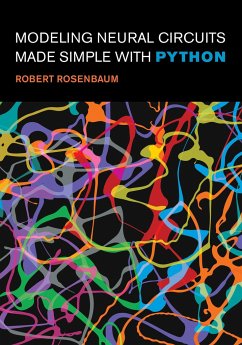Robert Rosenbaum
Modeling Neural Circuits Made Simple with Python
Robert Rosenbaum
Modeling Neural Circuits Made Simple with Python
- Broschiertes Buch
- Merkliste
- Auf die Merkliste
- Bewerten Bewerten
- Teilen
- Produkt teilen
- Produkterinnerung
- Produkterinnerung
"Rosenbaum explains at an advanced undergrad level, the core mathematical and computational models of neurons and networks of neurons, focusing primarily on neurons in the cerebral cortex"--
Andere Kunden interessierten sich auch für
![The Human Advantage The Human Advantage]() Suzana Herculano-Houzel (Vanderbilt University Associate ProfessorThe Human Advantage14,99 €
Suzana Herculano-Houzel (Vanderbilt University Associate ProfessorThe Human Advantage14,99 €![Carbon: One Atom's Odyssey Carbon: One Atom's Odyssey]() John BarnettCarbon: One Atom's Odyssey24,99 €
John BarnettCarbon: One Atom's Odyssey24,99 €![Sculptor and Destroyer Sculptor and Destroyer]() Mark P. MattsonSculptor and Destroyer43,99 €
Mark P. MattsonSculptor and Destroyer43,99 €![Body Am I Body Am I]() Moheb CostandiBody Am I17,99 €
Moheb CostandiBody Am I17,99 €![Some Assembly Required Some Assembly Required]() Neil ShubinSome Assembly Required19,99 €
Neil ShubinSome Assembly Required19,99 €![The Feeling of Life Itself The Feeling of Life Itself]() Christof KochThe Feeling of Life Itself28,99 €
Christof KochThe Feeling of Life Itself28,99 €![Of Sound Mind Of Sound Mind]() Nina KrausOf Sound Mind28,99 €
Nina KrausOf Sound Mind28,99 €-
-
-
"Rosenbaum explains at an advanced undergrad level, the core mathematical and computational models of neurons and networks of neurons, focusing primarily on neurons in the cerebral cortex"--
Produktdetails
- Produktdetails
- Verlag: MIT Press Ltd
- Seitenzahl: 176
- Erscheinungstermin: 19. März 2024
- Englisch
- Abmessung: 178mm x 253mm x 13mm
- Gewicht: 364g
- ISBN-13: 9780262548083
- ISBN-10: 0262548089
- Artikelnr.: 69433770
- Herstellerkennzeichnung
- Libri GmbH
- Europaallee 1
- 36244 Bad Hersfeld
- gpsr@libri.de
- Verlag: MIT Press Ltd
- Seitenzahl: 176
- Erscheinungstermin: 19. März 2024
- Englisch
- Abmessung: 178mm x 253mm x 13mm
- Gewicht: 364g
- ISBN-13: 9780262548083
- ISBN-10: 0262548089
- Artikelnr.: 69433770
- Herstellerkennzeichnung
- Libri GmbH
- Europaallee 1
- 36244 Bad Hersfeld
- gpsr@libri.de
Robert Rosenbaum
Contents
List of Figures ix
Preface xi
1 Modeling Single Neurons 1
1.1 The Leaky Integrator Model 1
1.2 The EIF Model 5
1.3 Modeling Synapses 10
2 Measuring and Modeling Neural Variability 15
2.1 Spike Train Variability, Firing Rates, and Tuning 15
2.2 Modeling Spike Train Variability with Poisson Processes 21
2.3 Modeling a Neuron with Noisy Synaptic Input 25
3 Modeling Networks of Neurons 33
3.1 Feedforward Spiking Networks and Their Mean-Field Approximation 33
3.2 Recurrent Spiking Networks and Their Mean-Field Approximation 37
3.3 Modeling Surround Suppression with Rate Network Models 43
4 Modeling Plasticity and Learning 49
4.1 Synaptic Plasticity 49
4.2 Feedforward Artificial Neural Networks 54
Appendix A: Mathematical Background 61
A.1 Introduction to ODEs 61
A.2 Exponential Decay as a Linear, Autonomous ODE 63
A.3 Convolutions 65
A.4 One-Dimensional Linear ODEs with Time-Dependent Forcing 69
A.5 The Forward Euler Method 71
A.6 Fixed Points, Stability, and Bifurcations in One-Dimensional ODEs 74
A.7 Dirac Delta Functions 78
A.8 Fixed Points, Stability, and Bifurcations in Systems of ODEs 81
Appendix B: Additional Models and Concepts 89
B.1 Ion Channel Currents and the HH Model 89
B.2 Other Simplified Models of Single Neurons 97
B.3 Conductance-Based Synapse Models 113
B.4 Neural Coding 115
B.5 Derivations and Alternative Formulations of Rate Network Models 124
B.6 Hopfield Networks 127
B.7 Training Readouts from Chaotic RNNs 131
B.8 DNNs and Backpropagation 136
References 141
Index 147
List of Figures ix
Preface xi
1 Modeling Single Neurons 1
1.1 The Leaky Integrator Model 1
1.2 The EIF Model 5
1.3 Modeling Synapses 10
2 Measuring and Modeling Neural Variability 15
2.1 Spike Train Variability, Firing Rates, and Tuning 15
2.2 Modeling Spike Train Variability with Poisson Processes 21
2.3 Modeling a Neuron with Noisy Synaptic Input 25
3 Modeling Networks of Neurons 33
3.1 Feedforward Spiking Networks and Their Mean-Field Approximation 33
3.2 Recurrent Spiking Networks and Their Mean-Field Approximation 37
3.3 Modeling Surround Suppression with Rate Network Models 43
4 Modeling Plasticity and Learning 49
4.1 Synaptic Plasticity 49
4.2 Feedforward Artificial Neural Networks 54
Appendix A: Mathematical Background 61
A.1 Introduction to ODEs 61
A.2 Exponential Decay as a Linear, Autonomous ODE 63
A.3 Convolutions 65
A.4 One-Dimensional Linear ODEs with Time-Dependent Forcing 69
A.5 The Forward Euler Method 71
A.6 Fixed Points, Stability, and Bifurcations in One-Dimensional ODEs 74
A.7 Dirac Delta Functions 78
A.8 Fixed Points, Stability, and Bifurcations in Systems of ODEs 81
Appendix B: Additional Models and Concepts 89
B.1 Ion Channel Currents and the HH Model 89
B.2 Other Simplified Models of Single Neurons 97
B.3 Conductance-Based Synapse Models 113
B.4 Neural Coding 115
B.5 Derivations and Alternative Formulations of Rate Network Models 124
B.6 Hopfield Networks 127
B.7 Training Readouts from Chaotic RNNs 131
B.8 DNNs and Backpropagation 136
References 141
Index 147
Contents
List of Figures ix
Preface xi
1 Modeling Single Neurons 1
1.1 The Leaky Integrator Model 1
1.2 The EIF Model 5
1.3 Modeling Synapses 10
2 Measuring and Modeling Neural Variability 15
2.1 Spike Train Variability, Firing Rates, and Tuning 15
2.2 Modeling Spike Train Variability with Poisson Processes 21
2.3 Modeling a Neuron with Noisy Synaptic Input 25
3 Modeling Networks of Neurons 33
3.1 Feedforward Spiking Networks and Their Mean-Field Approximation 33
3.2 Recurrent Spiking Networks and Their Mean-Field Approximation 37
3.3 Modeling Surround Suppression with Rate Network Models 43
4 Modeling Plasticity and Learning 49
4.1 Synaptic Plasticity 49
4.2 Feedforward Artificial Neural Networks 54
Appendix A: Mathematical Background 61
A.1 Introduction to ODEs 61
A.2 Exponential Decay as a Linear, Autonomous ODE 63
A.3 Convolutions 65
A.4 One-Dimensional Linear ODEs with Time-Dependent Forcing 69
A.5 The Forward Euler Method 71
A.6 Fixed Points, Stability, and Bifurcations in One-Dimensional ODEs 74
A.7 Dirac Delta Functions 78
A.8 Fixed Points, Stability, and Bifurcations in Systems of ODEs 81
Appendix B: Additional Models and Concepts 89
B.1 Ion Channel Currents and the HH Model 89
B.2 Other Simplified Models of Single Neurons 97
B.3 Conductance-Based Synapse Models 113
B.4 Neural Coding 115
B.5 Derivations and Alternative Formulations of Rate Network Models 124
B.6 Hopfield Networks 127
B.7 Training Readouts from Chaotic RNNs 131
B.8 DNNs and Backpropagation 136
References 141
Index 147
List of Figures ix
Preface xi
1 Modeling Single Neurons 1
1.1 The Leaky Integrator Model 1
1.2 The EIF Model 5
1.3 Modeling Synapses 10
2 Measuring and Modeling Neural Variability 15
2.1 Spike Train Variability, Firing Rates, and Tuning 15
2.2 Modeling Spike Train Variability with Poisson Processes 21
2.3 Modeling a Neuron with Noisy Synaptic Input 25
3 Modeling Networks of Neurons 33
3.1 Feedforward Spiking Networks and Their Mean-Field Approximation 33
3.2 Recurrent Spiking Networks and Their Mean-Field Approximation 37
3.3 Modeling Surround Suppression with Rate Network Models 43
4 Modeling Plasticity and Learning 49
4.1 Synaptic Plasticity 49
4.2 Feedforward Artificial Neural Networks 54
Appendix A: Mathematical Background 61
A.1 Introduction to ODEs 61
A.2 Exponential Decay as a Linear, Autonomous ODE 63
A.3 Convolutions 65
A.4 One-Dimensional Linear ODEs with Time-Dependent Forcing 69
A.5 The Forward Euler Method 71
A.6 Fixed Points, Stability, and Bifurcations in One-Dimensional ODEs 74
A.7 Dirac Delta Functions 78
A.8 Fixed Points, Stability, and Bifurcations in Systems of ODEs 81
Appendix B: Additional Models and Concepts 89
B.1 Ion Channel Currents and the HH Model 89
B.2 Other Simplified Models of Single Neurons 97
B.3 Conductance-Based Synapse Models 113
B.4 Neural Coding 115
B.5 Derivations and Alternative Formulations of Rate Network Models 124
B.6 Hopfield Networks 127
B.7 Training Readouts from Chaotic RNNs 131
B.8 DNNs and Backpropagation 136
References 141
Index 147








